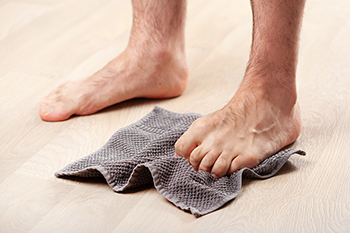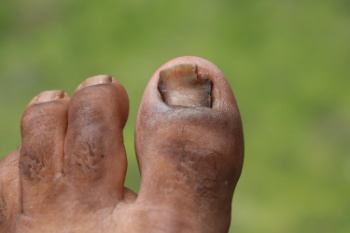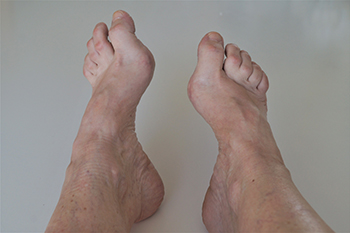Connect With Us

Types of Stress Fractures From Running

One significant risk facing runners is the potential for stress fractures, which are hairline cracks in one of many bones in the feet. Metatarsal stress fractures often occur in the 2nd or 3rd metatarsals, due to their structure and the forces exerted during running. Pronation can add to the amount of stress on these bones. Navicular stress fractures can be recognized as midfoot pain on the outside of the foot. This type of fracture is more common in runners with flat feet or those engaged in track and field or middle distance running. Calcaneus stress fractures cause heel pain, especially during weight-bearing activities. They are often the result of increased training intensity or frequency. Stress fractures in the big toe are most often found in the bone closest to the first metatarsal. These fractures occur due to repetitive loading during running, resulting in localized pain and swelling around the first metatarsophalangeal, or MTP, joint. If you have pain in your feet that may be the result of running, it is suggested that you schedule an appointment with a podiatrist for an exam and diagnosis.
Activities where too much pressure is put on the feet can cause stress fractures. To learn more, contact one of our podiatrists from Comprehensive Foot & Ankle Centers. Our doctors can provide the care you need to keep your pain free and on your feet.
Dealing with Stress Fractures of the Foot and Ankle
Stress fractures occur in the foot and ankle when muscles in these areas weaken from too much or too little use. The feet and ankles then lose support when walking or running from the impact of the ground. Since there is no protection, the bones receive the full impact of each step. Stress on the feet can cause cracks to form in the bones, thus creating stress fractures.
What Are Stress Fractures?
Stress fractures occur frequently in individuals whose daily activities cause great impact on the feet and ankles. Stress factors are most common among:
- Runners
- People affected with Osteoporosis
- Tennis or basketball players
- Gymnasts
- High impact workouts
Symptoms
Pain from the fractures occur in the area of the fractures and can be constant or intermittent. It will often cause sharp or dull pain with swelling and tenderness. Engaging in any kind of activity which involves high impact will aggravate pain.
If you have any questions please feel free to contact our offices located in Shepherdsville and Louisville, KY . We offer the newest diagnostic and treatment technologies for all your foot and ankle needs.
Dealing with Stress Fractures of the Foot and Ankle
Stress fractures are small breaks in the bone that are caused by repetitive stress. They typically occur due to overuse, forcing the bones of the foot or ankle to continually absorb the full impact of each step taken. Stress fractures can also be caused by abnormal foot structure, osteoporosis, bone deformities, or wearing improper footwear during exercise.
Stress fractures are common for individuals whose daily activities cause high levels of impact on their feet and ankles. Those who run, play tennis or basketball, or practice gymnastics tend to experience these fractures more frequently. Anyone is susceptible to this problem, though. Individuals who are normally sedentary and suddenly begin an intense, high impact workout may sustain stress fractures. This is because their muscles are not yet strong enough to handle and cushion the intensity of their activity. Osteoporosis may also cause someone to get stress fractures, because the disease weakens an afflicted person's bones and makes it easier for them to break down.
Pain from stress fractures typically occurs in the general area of the fracture. Pain can also manifest as “pinpoint pain” or pain that is felt when the site of the injury is touched, and can be accompanied by swelling. It may occur during or after activity, and it may disappear while resting and return when standing or moving. Engaging in any kind of activity, high impact or otherwise, will aggravate the pain. If the intensity of the activity increases before the stress fracture has properly healed, it can cause a full fracture.
Treatment can vary depending on the individual and the degree of injury. The primary way to treat a stress fracture is to rest the hurt foot. Some fractures will heal quickly with only a little bit of rest, while others may require a long rest period and the use of crutches, immobilization, or physical therapy. Under certain circumstances, surgery may be required to install support pins around the fracture to assist in healing.
If you are undergoing a new exercise regimen in running or some other kind of high impact activity, set incremental goals on a weekly basis so you can build up muscle strength. Make sure to wear supportive shoes to better protect you feet.
If you begin to experience any symptoms of stress fractures, you should stop exercising and rest. If the symptoms persist, consult with your podiatrist. Remembering these tips can help you prevent stress fractures to your foot and ankle, and allow you to continue living normally.
Rehabilitation Exercises for a Broken Toe

Recovering from a broken toe can be a frustrating journey, but with the right exercises, you can expedite the healing process and regain strength and flexibility in your toe. Start with passive toe exercises, where you sit comfortably and use gentle movements to bend your toe forward and backward, gradually increasing flexibility. Toe curls help to strengthen the muscles surrounding the toe, promoting stability and mobility. Towel scrunches provide a great opportunity to work on grip strength and dexterity by using your toes to scrunch a towel towards you and then push it back. Marble pick-ups add a fun and challenging element to your routine as you aim to pick up marbles with your toes and place them into a cup, which improves coordination and control. Lastly, the towel stretch helps to elongate the muscles and tissues in the toe, enhancing flexibility and reducing stiffness. Consistency is key, so aim to incorporate these exercises into your daily routine to support a speedy recovery. If you need help in dealing with a broken toe, it is suggested that you make an appointment with a podiatrist.
Broken toes may cause a lot of pain and should be treated as soon as possible. If you have any concerns about your feet, contact one of our podiatrists from Comprehensive Foot & Ankle Centers. Our doctors will treat your foot and ankle needs.
What Is a Broken Toe?
A broken toe occurs when one or more of the toe bones of the foot are broken after an injury. Injuries such as stubbing your toe or dropping a heavy object on it may cause a toe fracture.
Symptoms of a Broken Toe
- Swelling
- Pain (with/without wearing shoes)
- Stiffness
- Nail Injury
Although the injured toe should be monitored daily, it is especially important to have a podiatrist look at your toe if you have severe symptoms. Some of these symptoms include worsening or new pain that is not relieved with medication, sores, redness, or open wounds near the toe.
If you have any questions, please feel free to contact our offices located in Shepherdsville and Louisville, KY . We offer the newest diagnostic and treatment technologies for all your foot care needs.
What to Know About a Broken Toe
The forefoot is composed of five metatarsal bones and fourteen phalanges. Each toe has three phalanges except for the big toe which only has two. Our toes play an essential role to the walking process, which is why a broken toe could seriously disrupt one’s ability to move around. Toe fractures are common and can be very painful. Fortunately, these injuries rarely require surgery and usually heal with rest and a change in activity.
Broken toes typically result from a traumatic event such as falling, stubbing the toe, or dropping something on the toe. Traumatic toe fractures may be categorized as either minor or severe fractures. At times, one may hear a “pop” or “crack” sound when the bone breaks. Common symptoms of a traumatic toe fracture include pain, throbbing, bruising, swelling, and redness.
Another type of toe fractures is a stress fracture. These injuries usually appear in the form of small hairline breaks on the bone. Stress fractures develop after repetitive activity instead of a single injury. Stress fractures occur when the muscles in the bone become too weak to absorb impact. Consequently, the toe bone becomes vulnerable to any pressure and impact it endures. Symptoms for a stress fracture in the toe include swelling without bruising, tenderness to the touch, pain that goes away with rest, and pain after walking or running.
If you suspect that you have a broken toe, you should make an appointment with your podiatrist. He or she will likely diagnose you by performing a physical exam and an X-ray. Treatment for a broken toe may include the R.I.C.E. method, buddy taping, surgery, or antibiotics. The R.I.C.E. method (Rest, Ice, Compression, and Elevation) is a common treatment method for many injuries because it decreases pain. Buddy tapping involves wrapping the injured toe next to an adjacent toe to keep it supported and protected. These two methods have proven to be effective in the healing process for toe fractures. The estimated healing time for a broken toe is approximately four to six weeks. If the injury becomes infected or requires surgery, the estimated healing time may take eight weeks or more.
Professional Removal of Corns

Corns, small areas of thickened skin that develop on the feet due to friction or pressure, can cause discomfort and pain if left untreated. These hardened patches often form on areas of the feet subjected to repeated rubbing from ill-fitting shoes, abnormal foot mechanics, or prolonged standing. Corns can interfere with daily activities, and professional removal methods offer long-lasting solutions for persistent corns. Podiatrists and foot specialists employ various techniques to safely and effectively remove corns, depending on their severity and location. Common removal methods include paring, where the thickened skin is carefully trimmed using specialized instruments, and chemical treatments, such as salicylic acid solutions, to dissolve the hardened tissue. In cases where corns are deeply embedded or accompanied by underlying foot issues, podiatrists may recommend orthotic devices or corrective measures to alleviate pressure and prevent recurrence. Seeking professional care from a podiatrist for corn removal ensures proper treatment and reduces the risk of complications, promoting optimal foot health and comfort for individuals dealing with this foot ailment. If you have a corn on your foot, it is suggested that you schedule an appointment with a podiatrist who can successfully remove the corn, in addition to offering you effective prevention techniques.
Corns can make walking very painful and should be treated immediately. If you have questions regarding your feet and ankles, contact one of our podiatrists of Comprehensive Foot & Ankle Centers. Our doctors will treat your foot and ankle needs.
Corns: What Are They? And How Do You Get Rid of Them?
Corns are thickened areas on the skin that can become painful. They are caused by excessive pressure and friction on the skin. Corns press into the deeper layers of the skin and are usually round in shape.
Ways to Prevent Corns
There are many ways to get rid of painful corns such as:
- Wearing properly fitting shoes that have been measured by a professional
- Wearing shoes that are not sharply pointed or have high heels
- Wearing only shoes that offer support
Treating Corns
Although most corns slowly disappear when the friction or pressure stops, this isn’t always the case. Consult with your podiatrist to determine the best treatment option for your case of corns.
If you have any questions please feel free to contact our offices located in Shepherdsville and Louisville, KY . We offer the newest diagnostic and treatment technologies for all your foot and ankle needs.
Everything You Need to Know About Corns
Corns are hard and thick areas of skin that form as a result of constant rubbing, friction, or pressure on the skin. They are patches of dead skin with a small plug toward the center. They may appear on the tops and sides of toes and can make walking painful.
Soft corns are typically thinner with a white color and rubbery texture. Soft corns tend to appear between the toes. Seed corns are another type of corn that appear in clusters and can be tender if they are on a weight-bearing part of the foot. Seed corns usually appear on the bottom of the foot and are likely caused by a blockage in sweat ducts.
While corns and calluses are somewhat similar, calluses are a bit different. Calluses are a patch of dead skin that can occur anywhere on the body. In comparison to corns, calluses are usually a bit larger in size. However, both corns and calluses are caused by increased friction on the skin.
There are some risk factors that may increase your chances of developing corns and calluses. If you have bunions, hammertoe, or a bone spur, you are more likely to develop a corn or callus on your foot.
While Corns and Calluses tend to disappear when the friction to the affected area ceases, the help of a podiatrist may be useful in the removal process. It is important to remove the dead skin around the area and this may be done in a few different ways. Moisturizing creams may be helpful in softening and removing the dead skin around the callus. You should never use razors or other pedicure equipment to remove your corns. Doing this may worsen your corn or callus and cause infection.
In some cases, corns and calluses may be caused by abnormal foot structure or walking motion. In such a case, you should seek a podiatrist’s assistance in order to correct the issue.
How the Right Shoes Help Prevent Toenail Fungus
 Toenail fungus, a common and contagious nail infection, can be impacted by footwear. Understanding how shoes can contribute to toenail fungus is the first step toward the prevention and recurrence of fungal infections. Tight, ill-fitting shoes create the right environment for fungus to grow, because these shoes trap sweat and moisture and provide a warm, dark space. Airflow helps keep feet dry, but tighter shoes often don’t have good ventilation. On the other hand, breathable, moisture-wicking footwear can reduce the risk of toenail fungus. Fungal infections are contagious, so it’s best to avoid sharing shoes. Regularly disinfecting shoes can also help prevent the spread of fungal infections. Not only are your feet happier overall when you prioritize comfort, proper fit, and breathability in your shoes, but you also minimize the likelihood of toenail fungus taking hold and persisting. If you suspect toenail fungus, it is suggested you consult with a podiatrist who can provide a treatment plan and personalized recommendations for footwear.
Toenail fungus, a common and contagious nail infection, can be impacted by footwear. Understanding how shoes can contribute to toenail fungus is the first step toward the prevention and recurrence of fungal infections. Tight, ill-fitting shoes create the right environment for fungus to grow, because these shoes trap sweat and moisture and provide a warm, dark space. Airflow helps keep feet dry, but tighter shoes often don’t have good ventilation. On the other hand, breathable, moisture-wicking footwear can reduce the risk of toenail fungus. Fungal infections are contagious, so it’s best to avoid sharing shoes. Regularly disinfecting shoes can also help prevent the spread of fungal infections. Not only are your feet happier overall when you prioritize comfort, proper fit, and breathability in your shoes, but you also minimize the likelihood of toenail fungus taking hold and persisting. If you suspect toenail fungus, it is suggested you consult with a podiatrist who can provide a treatment plan and personalized recommendations for footwear.
For more information about treatment, contact one of our podiatrists of Comprehensive Foot & Ankle Centers. Our doctors can provide the care you need to keep you pain-free and on your feet.
Toenail Fungus Treatment
Toenail fungus is a condition that affects many people and can be especially hard to get rid of. Fortunately, there are several methods to go about treating and avoiding it.
Antifungals & Deterrence
Oral antifungal medicine has been shown to be effective in many cases. It is important to consult with a podiatrist to determine the proper regiment for you, or potentially explore other options.
Applying foot powder on the feet and shoes helps keep the feet free of moisture and sweat.
Sandals or open toed shoes – Wearing these will allow air movement and help keep feet dry. They also expose your feet to light, which fungus cannot tolerate. Socks with moisture wicking material also help as well.
If you have any questions please feel free to contact our offices located in Shepherdsville and Louisville, KY . We offer the newest diagnostic tools and technology to treat your foot and ankle needs.
How to Treat Your Toenail Fungus
While not a serious issue, toenail fungus, or onychomycosis, can be an embarrassing and uncomfortable condition to experience. Toenail fungus is often caused from public areas that harbor fungi and improper cleaning/drying of the foot. Once infected, the fungus grows deeper into the nail and can be very hard to get rid of.
There are different types of fungus that cause toenail fungus. Dermatophytes, yeasts, and molds are the most frequent forms of fungus to infect the toenail. Dermatophytes are the most common among the three. Symptoms associated with fungal nails include the discoloration of the toenail, brittleness, and in some circumstances, a smell. Pain is rarely a symptom caused by toenail fungus.
Diagnosis of fungal nails is generally a rather quick process. However podiatrists will make sure that the cause is not another condition such as lichen planus, psoriasis, onychogryphosis, or nail damage. Podiatrists will make use of fungal cultures and microscopy to verify that it is fungus.
While over-the-counter ointments are readily available, most are ineffective. This is due to the fact that the nail is very protective and that the fungus slips in between the nail plate and bed. Podiatrists can offer oral medication which currently provides the best results.
Ultimately, prevention is the best line of defense against toenail fungus. Avoid unsanitary public showers. If you do use a public shower, use shower shoes to provide your foot with protection. Once you are finished showering, make sure to thoroughly dry your feet. Fungi thrive in warm, dark, and moist places like sweaty, warm feet that are left dark in shoes all day.
Causes and Types of High Arches

Understanding pes cavus, commonly known as a high-arched foot, is essential for managing its impact on foot health, especially as you age and the risk of falls increases. Pes cavus can develop due to various reasons. Included are nerve conditions like Charcot-Marie-Tooth disease, spine issues, or past polio infections, leading to muscle imbalances and weakness in the feet and ankles. The three main types of pes cavus are when the heel is turned inward, pushed up, and when the arch is just very high. Each type has its own signs and can be seen on special X-rays. Symptoms of pes cavus can include foot pain, feeling unstable when walking, and having trouble finding comfortable shoes, which usually get worse as the arch gets higher. Treatment usually starts with non-surgical options like custom orthotics and exercises to improve balance. In more severe cases, surgery might be needed to fix the foot's shape and reduce pain. If you are experiencing foot pain or balance issues that may be related to high arches, it is suggested that you schedule an appointment with a podiatrist for an exam and diagnosis.
If you have any concerns about your feet, contact one of our podiatrists from Comprehensive Foot & Ankle Centers. Our doctors can provide the care you need to keep you pain-free and on your feet.
Biomechanics in Podiatry
Podiatric biomechanics is a particular sector of specialty podiatry with licensed practitioners who are trained to diagnose and treat conditions affecting the foot, ankle and lower leg. Biomechanics deals with the forces that act against the body, causing an interference with the biological structures. It focuses on the movement of the ankle, the foot and the forces that interact with them.
A History of Biomechanics
- Biomechanics dates back to the BC era in Egypt where evidence of professional foot care has been recorded.
- In 1974, biomechanics gained a higher profile from the studies of Merton Root, who claimed that by changing or controlling the forces between the ankle and the foot, corrections or conditions could be implemented to gain strength and coordination in the area.
Modern technological improvements are based on past theories and therapeutic processes that provide a better understanding of podiatric concepts for biomechanics. Computers can provide accurate information about the forces and patterns of the feet and lower legs.
Understanding biomechanics of the feet can help improve and eliminate pain, stopping further stress to the foot.
If you have any questions please feel free to contact our offices located in Shepherdsville and Louisville, KY . We offer the newest diagnostic and treatment technologies for all your foot and ankle needs.







